Belarus Tour Guide: Ideas for Your Trip!
Belarus’ Iconic Experiences
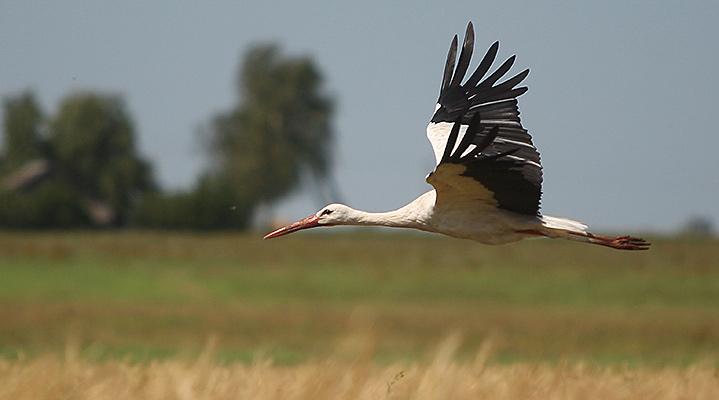
Traveling is not just about a hundred photos in your smartphone or another mark on the world map. Traveling is about bright emotions and new experiences. Any corner of the planet can surprise you. Belarus is no exception! Natural and man-made sights, centuries-old rites, architectural gems, delicious food… Everyone can find something to their liking here.
Visit Europe's largest relic forest and count bison
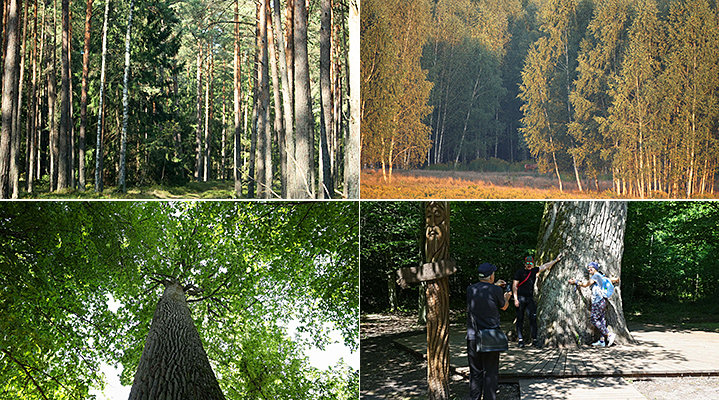
Belovezhskaya Pushcha is one of the most famous natural attractions in Europe and the world. This amazing old-growth forest is located in two countries: Belarus and Poland. It was recognized a UNESCO World Heritage Site (a joint nomination) in 1992.
Belovezhskaya Pushcha is the oldest reserve in Europe: in 1409 King Jahajla banned hunting in this forest for all but himself and Prince Vytautas.
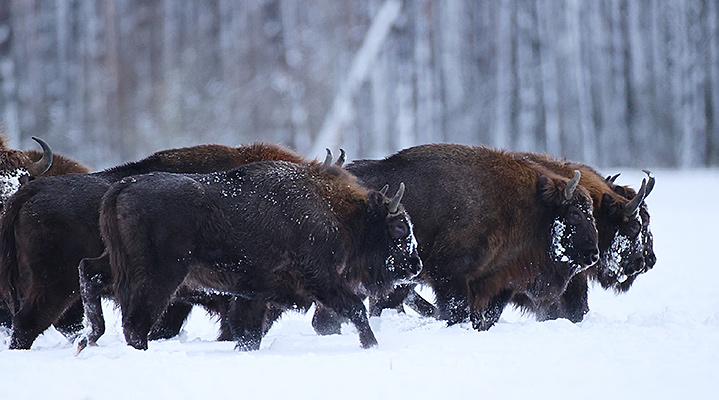
Some trees are more than 500 years old. It is likely that some oaks ‘witnessed’ the grand dukes. The wealth of the forest is astonishing! Today, the reserve keeps the pedigree book of European bison as Belovezhskaya Pushcha is home to the world’s largest herd of bison saved from extinction. The local herd numbers 604 head (and many more roam in other forests of Belarus), and 770 animals live on the Polish side.
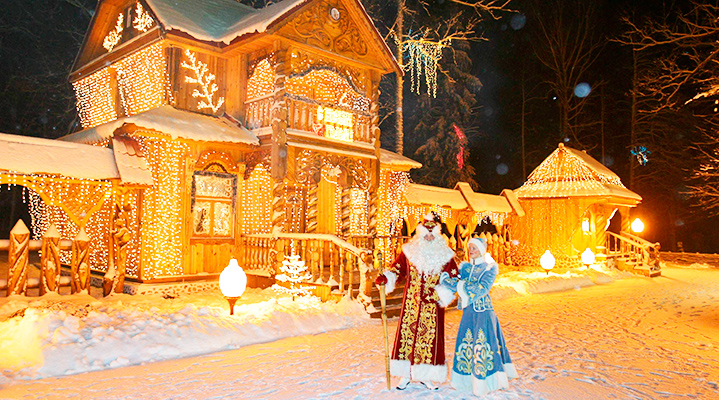
Belovezhskaya Pushcha is also home to the estate of Belarusian Grandfather Frost. He receives visitors not only in winter but all year round. The residence of the main New Year's sorcerer was opened in December 2003. The estate spans an area of 15 hectares encompassing the house of Grandfather Frost, the chamber of Snow Maiden, Magic Mill that grinds bad deeds into dust and sand, Treasury Trove, Twelve Months’ place, New Year's Tree, and the Zodiac Signs alley. The first monument to New Year was unveiled here as the residence of the Belarusian Grandfather Frost marked its 15th anniversary. Every year the estate welcomes about 150,000 guests.
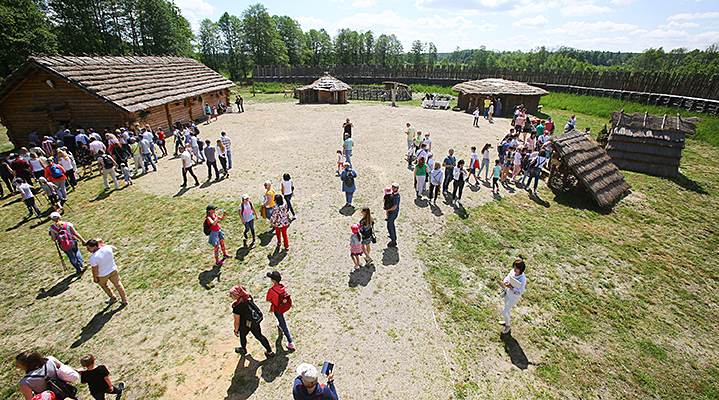
Europe's oldest forest is perhaps the best place to immerse yourself in history. The local open-air archaeological museum narrates the history of our ancestors more interestingly than textbooks. The unique museum features three exhibitions: “The settlement of the Late Bronze, Early Iron Age”, “Ancient German settlement of the Iron Age” and “Slavic settlement of the Early Middle Ages”. Here you can see how people built fortifications to defend themselves against enemy raids, how an ancient household looked like.
To see UNESCO World Heritage sites, other beautiful castles
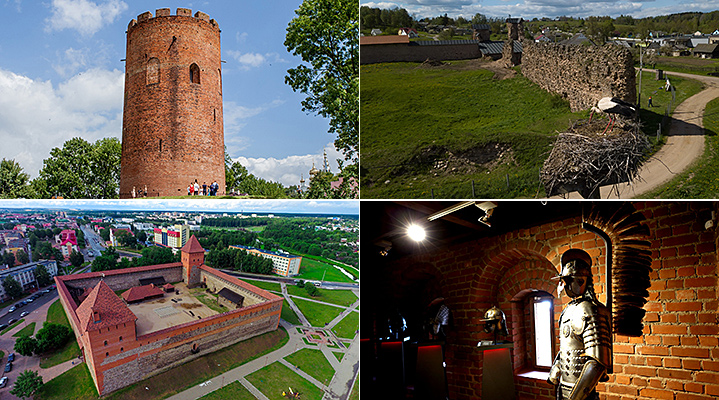
There were many wars, both local and global, in the history of Belarus. In the Middle Ages it was difficult to imagine cities without fortifications. At first those were wooden castles as timber was in abundance, and such fortifications were built quickly. Yet, they burned even faster.
With the improvement of siege weapons the time came for stone citadels. At first, stone towers were built next to wooden fortifications. An example of such a tower can be found in the town of Kamenets, Brest Oblast. A brick tower about 31m high, built in the late 13th century in the Romanesque style was called the White Tower (Belaya Vezha). Kreva Castle (late 13th - early 14th centuries) and Lida Castle (early 14th century) were modeled on Teutonic castles. Kreva Castle was the first in the Grand Duchy of Lithuania to be completely built of brick and stone.
More than a hundred castles were built in Belarus in the 13th - 18th centuries, but, unfortunately, most of them have not survived, not even ruins. However, Belarus is home to some real architectural gems that are worth seeing!
Mir Castle
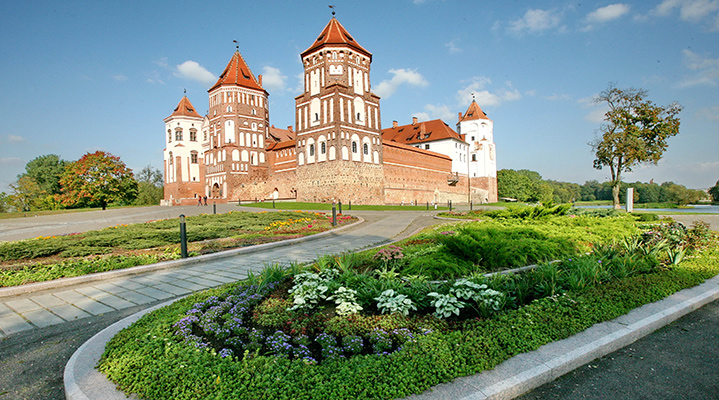
Mir Castle, one of the examples of defense architecture, was added to the UNESCO World Heritage List in 2000. The castle in the town of Mir was built in the early 16th century by magnate Yuri Ilinich and was the first stone fortification in private ownership on Belarusian lands. It is noteworthy that Mir Castle is the easternmost castle built in Gothic style.
The citadel has five towers 25 meters high. Each tower could withstand attacks independently of the others. The walls linking the towers are 3 meters thick and 13 meters high. The castle was affected by almost all the wars that took place in the territory of Belarus.
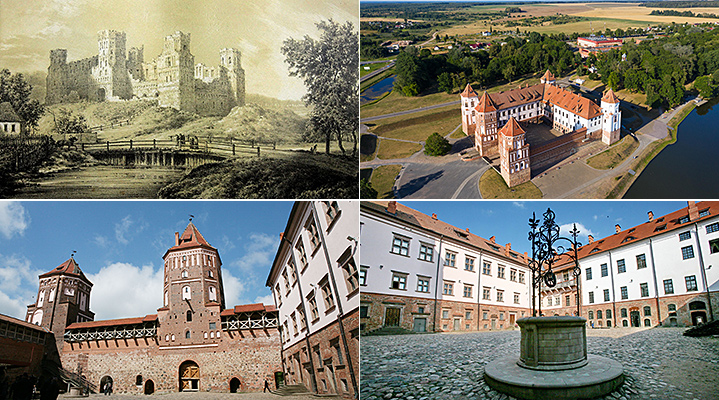
The Ilinichs could not complete the construction. In 1568 Yuri Ilinich Jr., the grandson of the founder of the castle, bequeathed this place to Prince Mikolaj Krzysztof Radziwill the Orphan. For three centuries Mir was the property of one of the most powerful princely families of the Grand Duchy of Lithuania. The Radziwill family converted the citadel into a Renaissance-style palace: a three-story residential building was attached to the northern and eastern walls, the towers were converted into living quarters. After a castle was built in Nesvizh, Mikolaj Krzysztof Radziwill made it his permanent place of residence and used Mir Castle for his countryside escapes.
The Mir citadel was destroyed during hostilities and rebuilt several times. During the Patriotic War of 1812, the castle was seriously damaged. Long disputes over the ownership rights also affected the condition of the Radziwills’ former residence. It got to the point that this specimen of military architecture was on the brink of destruction. Fortunately, this did not happen. The Wittgensteins, the then owners of the Mir lands, reconstructed the castle and in 1891 sold it to Cossack ataman Nikolai Svyatopolk-Mirsky.
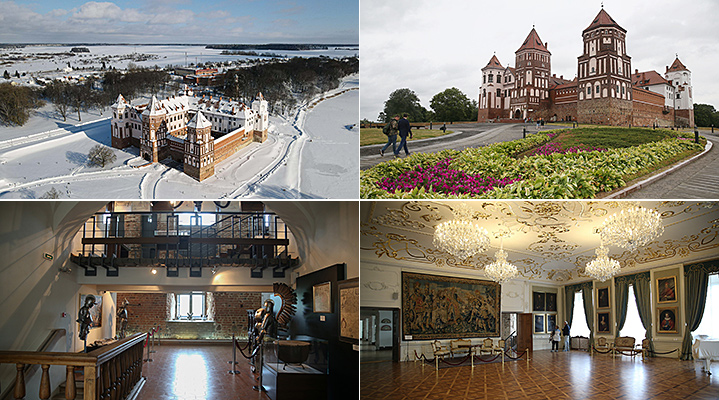
The restoration effort continued through the 1920s and took a total of 16 years. The work was supervised by architect Theodore Burchet. Part of the eastern building and two towers were repaired. In 1939, Mir Castle, along with the rest of Western Belarus, became part of the Soviet Union ... In independent Belarus, this architectural gem went through the most ambitious restoration project. It was recognized a UNESCO World Heritage Site and one of the most beautiful castles in Europe. Every year the palace-turned-museum welcomes thousands of visitors from around the world.
Palace in Nesvizh
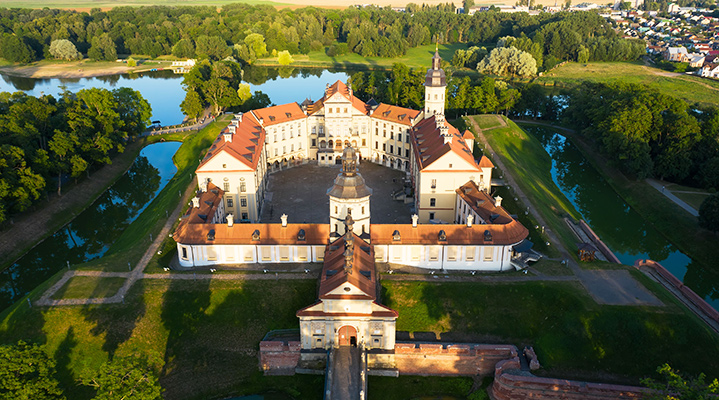
Another specimen of Belarusian military architecture was inscribed on the UNESCO World Heritage List in 2005. A castle in Nesvizh was founded by Prince Mikolaj Krzysztof Radziwill the Orphan in 1583 on the site of a wooden fortification. The Italian architect Giovanni (Gian) Maria Bernardoni took part in the construction project at some stages.
The castle represented a new type of bastion fortifications on the Belarusian lands - the so-called New Italian system. Built on the right bank of the Usha River, it was designed to have a quadrangle shape 170mx120m, surrounded by a high rampart and a wide moat. A princely palace was built in front of the entrance gate. The fortress had barracks, a prison, a foundry, warehouses with food supplies, and a bakery. A wooden bridge linked the castle with the town; the bridge could be easily disassembled in the event of a threat.
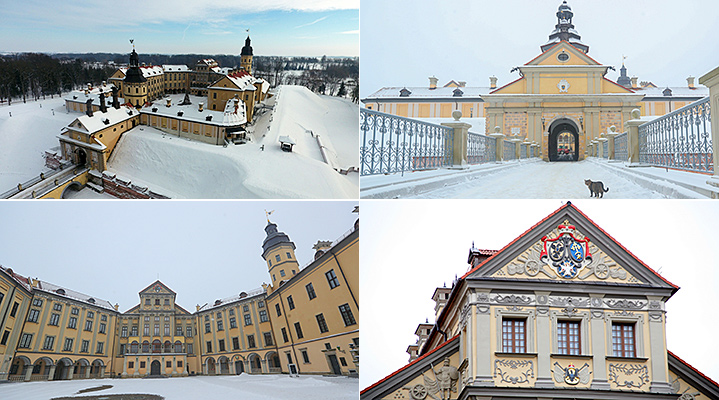
The fortress was besieged and destroyed more than once during military conflicts. In the 1720s century, in the course of another restoration project, the castle that was initially designed as a stronghold changed its purpose. Michal Kazimierz Radziwill the Rybenko ordered to turn the castle into a Baroque-style palace, the way we know it today. Under the prince, Nesvizh regained the status of the central ancestral domain of the Radziwill family. A chapel was built at the palace, a serf theater was opened.
In the mid-18th century, an internal conflict erupted in the Polish-Lithuanian Commonwealth - a representative of the Saxon House of Wettin and a pro-Russian candidate Stanislaw August Poniatowski claimed the throne. The then owner of Nesvizh Prince Karol Stanislaw Radziwill known by the sobriquet Panie Kochanku was in opposition to the government. Empress Catherine II intervened in this conflict and sent troops following the request of the Czartoryski family to support their candidate. The castle fell, Karol Radziwill fled the country ... Panie Kochanku returned from exile in 1780 and with his usual zeal embarked on restoring the castle in Nesvizh. In 1784, the Royal Hall was created in the run-up to the arrival of Stanislaw August Poniatowski.
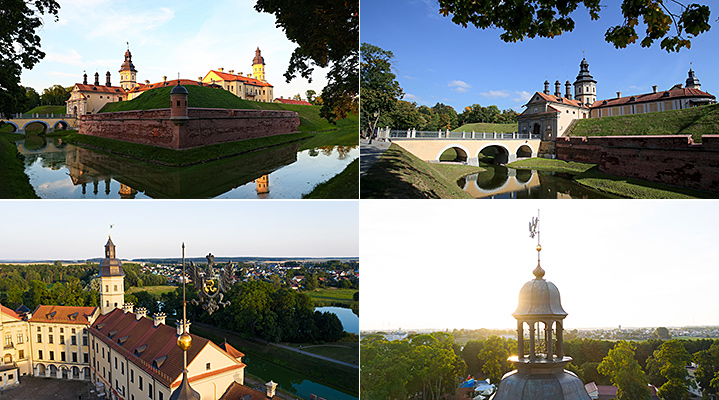
In 1812, Dominic Hieronymus Radziwill, the 11th custodian of Nesvizh, sided with Napoleon. The prince joined the French army, was seriously wounded on the battlefield and died in 1813. The estate passed into the possession of Antoni Henryk Radziwill. Having assumed the responsibility for the estate, he was on the verge of bankruptcy. It took almost two decades to reverse the situation and to turn the property into a profitable business.
The subsequent owners of the castle took almost no interest in it and did not live there. Neglected, the palace fell into disrepair. Antoni Wilhelm Radziwill and his wife Marie Dorothea de Castellane-Radziwill visited their Nesvizh estate for the first time in 1865. At that time the castle was a sad sight and was almost unsuitable for living. Restoration works began, and 10 years later the Radziwill family settled back in the family nest. Antoni Radziwill managed to return some of the valuables. Marie Dorothea ordered to plant beautiful parks around the castle. After Western Belarus became part of the USSR, the Radziwill family left Nesvizh.
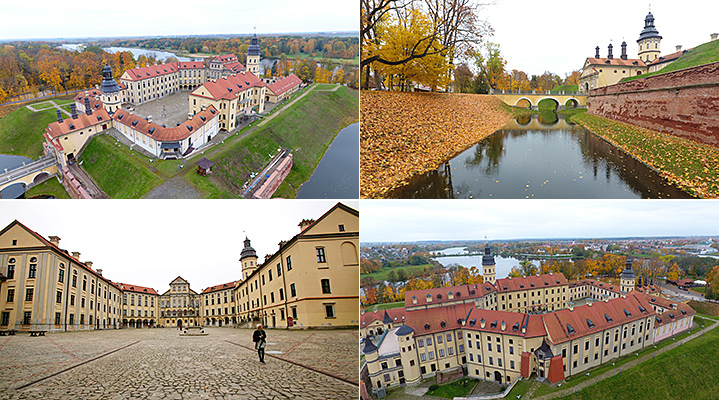
Following a major makeover in 2004-2011, the Nesvizh residence reopened as part of a memorial estate.
Make a check-in on the planet’s largest geodetic instrument
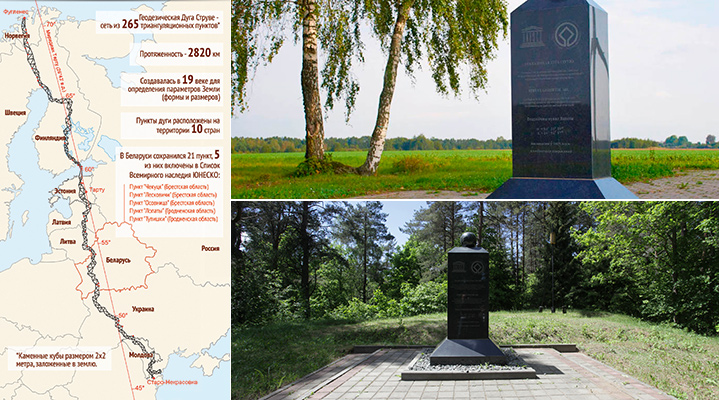
The famous Struve Geodetic Arc passes through Belarus. It was once a network, or rather a “chain” of 265 triangulation points, 2,820km long, running through Norway, Sweden, Finland, Estonia, Latvia, Lithuania, Belarus, Ukraine and Moldova. The arc was built from 1816 to 1855 for the first accurate measurement of a meridian arc.
Eleven of the 31 points in the country have been lost forever. Of the surviving ones five are included in the UNESCO World Heritage List: two in Grodno Oblast (Tupishki, Lopaty), three in Brest Oblast (Leskovichi, Osovnitsa, Chekutsk). One of them is an astronomical observatory. In Belarus, it is the only one out of 13 major points for degree measurements.
Get Europe’s geographical midpoint certificate
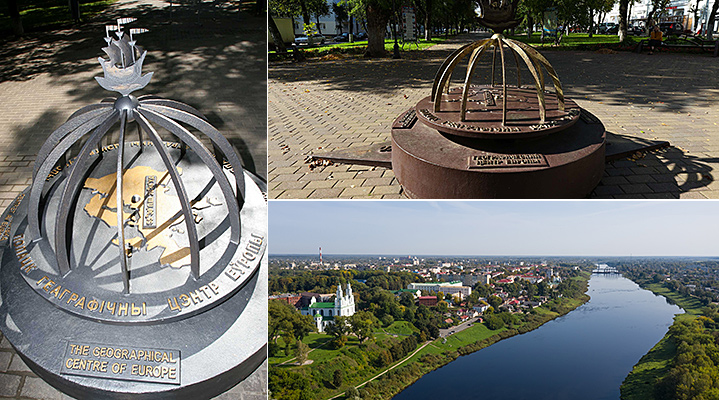
There are at least five locations currently vying for the distinction of being the center of Europe. These locations are in Belarus, Ukraine, Lithuania, Slovakia and Poland. The location of the geographical center of Europe depends on the definition of the borders of Europe and on the method of calculating the final result.
One of the centers of Europe is located near Lake Sho (5510′55′′ N, 2815′30′ E), 48km south-west of the city of Polotsk. This point was calculated by Belarusian scientists Aleksei Solomonov and Valery Anoshko in 2000 with the help of a special computer program.
In 2008 a monument to the Geographical Center of Europe was set up not on the place of the immediate center near the lake, but in Polotsk, the oldest city in Belarus. The city was first mentioned in chronicles in 862.
Here, one can get a midpoint certificate and also see the unique sights of the city, which has a special place in the history of both Belarus and Europe.
Visit the world's first museum dedicated to the bloodiest war of the 20th century
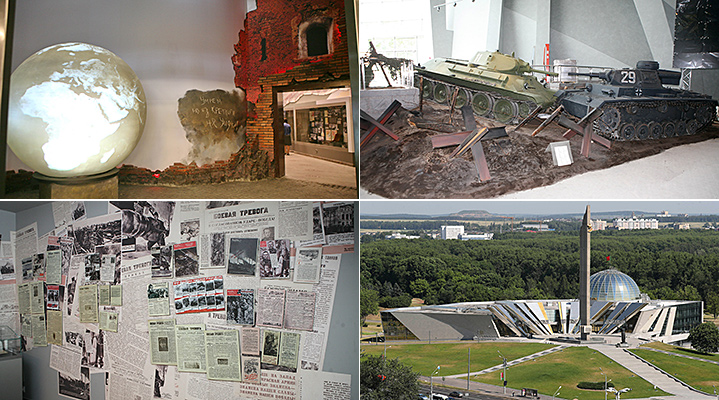
In the heat of the Great Patriotic War in 1942 a decision was taken to collect materials and documents about it. All the materials were accumulated by a special commission in Moscow. In November 1942 the exhibits collected by that time went on display at the exhibition “Belarus lives, Belarus fights, Belarus will remain Soviet” in Moscow. The exhibited items included documents, homemade weapons, partisan journals, soldiers’ personal belongings. The horrors of the war and the heroism of the native land defenders bobbled the imagination. After a very short time it became clear that the Second World War would go down in history as the bloodiest tragedy of mankind.
After Belarus was liberated from the Nazis, the exhibition was relocated to the almost destroyed Minsk on 22 October 1944. In 1966, the Museum of the History of the Great Patriotic War moved into a new building in the center of the city. The collection is continuously growing, with a number of new items reaching 800 a year. After Belarus gained independence, a decision was made to build a new modern building for the museum. The renewed museum opened near the Minsk Hero City Monument on 2 July 2014.
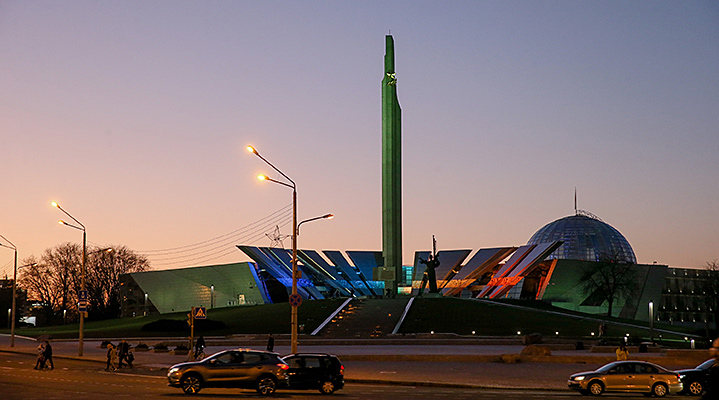
Throughout its centuries-long history, Belarus was involved in various military conflicts. Each of them took many lives. About 3 million residents of Belarus - almost every third - were killed in the Great Patriotic War. About 9,000 memorials and war graves were set up across the country in memory of this terrible tragedy.
Admire Minsk from top of a rhombicuboctahedron, one of world's top 50 unusual buildings
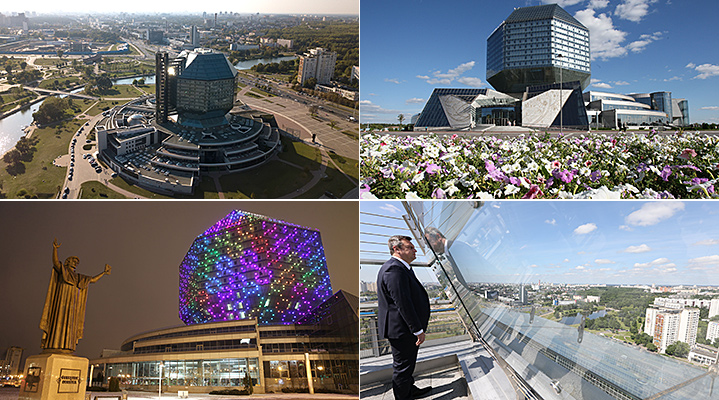
One of the most unusual buildings not only in Minsk, but also in the world was built in 2006. The ‘diamond’ with 26-faces and the height of almost 74 meters is located on Nezavisimosti Avenue near the Slepyanka Water System. The new building of the National Library was designed as far back as 1989, but due to various circumstances, the project got the go-ahead only 13 years later.
‘The diamond of knowledge’ is one of the highest buildings in Minsk. It has an observation deck that offers a view of almost the entire city.
The library has frequently featured in the lists of the most unusual architectural structures in the world. For example, in 2013, the U.S. edition Flavorwire gave it the 11th spot in its ranking of Works of Architecture That Belong in a Sci-Fi Film. The National Library also placed 24th in the ranking of the most unusual works of architecture in the world compiled by the Village of Joy website.
Find the fern flower and take part in unique folk rites
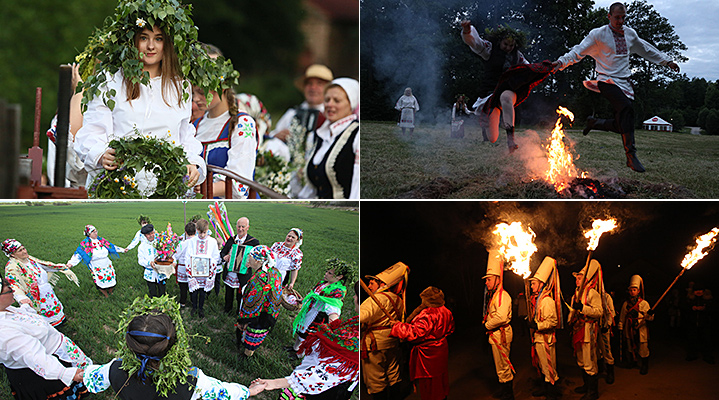
On the night of 6-7 July, Belarus celebrates the ancient fest Kupala Night. For centuries, people have been trying to find the mythical fern flower that blossoms only once a year, as a legend says. The mythical flower gives the person who finds it the ability to see the future, find all the world’s hidden treasures, and speak with animals. According to the legend, only a very bold person can find the fern flower. On Kupala Night, Belarusians also conduct the ritual of purification by fire and do fortune telling…
Belarusians carefully uphold other ancient traditions. Throughout the year, beautiful rites are re-enacted in various parts of the country. They include the Kolyady Tsars winter rite from the village of Semezhevo inscribed on the UNESCO List of Intangible Heritage and the spring rite Yurievsky Khorovod from the village of Pogost. Many Belarusian villages have their own unique traditions that are passed from generation to generation. The most interesting rites are re-enacted for visitors at ethnographic museums and rural tourism estates.
Watch birds and walk in galoshes on one of Europe’s largest bogs
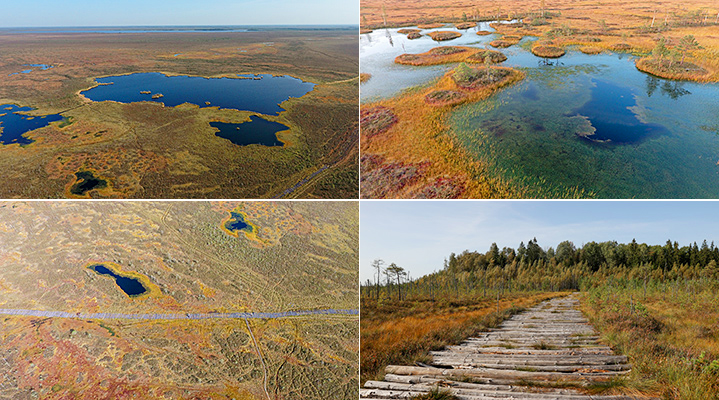
Belarus is not only a land of castles but also a land of swamps that occupy around 10% of the country’s territory despite a large-scale land reclamation campaign in the 20th century. Our ancestors believed that swamps were home to various evil creatures, for example, ‘bahniks’ (from the Belarusian word for ‘bog’) and that the mythical fern flower grew there. Swamps help maintain the stability of ecosystems and preserve biodiversity. They are also unusual tourist destinations.
Yelnia is the largest raised bog in Belarus and the fifth-largest in Europe. It is located in Miory District and Sharkovshchina District of Vitebsk Oblast. In 1968, Belarus established the Yelnia Landscape Reserve. It was designated as a Ramsar site in 2002. This natural system includes 118 bog lakes, the largest one of which – also named Yelnia – is more than five square kilometers big.
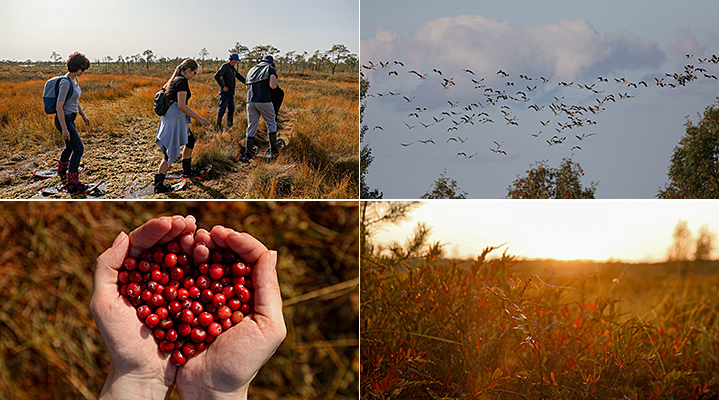
The landscape of the bog does not allow humans to build extensive infrastructure there. Thanks to this, the bog is home to unique animal and plant species, including the black-throated loon, the willow ptarmigan, the dwarf birch, and the cloudberry. In autumn, numerous flocks of common cranes and wild ducks stop at Yelnia on their way south. In turn, they draw flocks of birdwatchers and visitors to the festival “Cranes and Cranberries of Miory District”.
Yelnia visitors can admire its stunning landscapes thanks to a nature trail that is more than 1.5km long. There are also hiking and cycling routes. Visitors are invited to walk the bog in galoshes, pick up cranberries, and make photos of breathtaking sceneries.
Descend into mines of Europe’s largest potash salt deposit
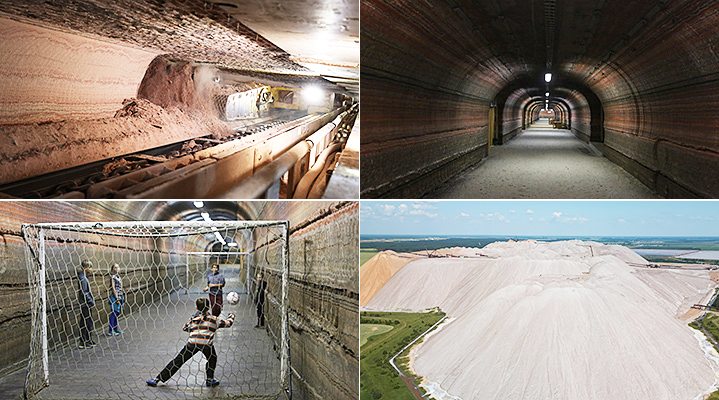
Belarus is home to Europe’s biggest potash salt deposit – the Starobinskoye deposit – that occupies 350 square kilometers. It was discovered in 1949. Its exploration started ten years later. Soligorsk, the city of miners, was founded in the vicinity around the same time. Belarus boasts large potash salt deposits thanks to the sea that existed here around 300 million years ago.
The mines are also used for recuperation purposes. In 1986, Belarus launched the construction of the first underground speleotherapy complex and hospital at the first mine. In 1990, the facility welcomed its first patients in the salt caves 420m below the surface level.
See the continent’s largest granite quarry
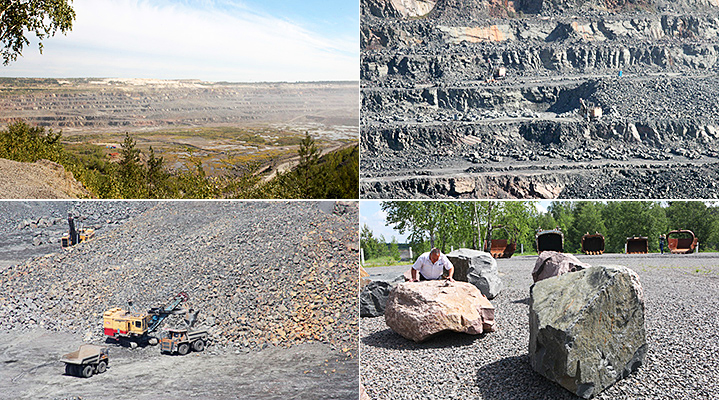
Did you know that Europe’s largest granite quarry is located in the small town of Mikashevichi, Brest Oblast? Granit is Europe’s leading manufacturer of broken stone. The first explosion blew up local rocks in 1973, nearly 50 years ago. The quarry is now 150 meters deep and can become 210 meters deep in the future. The bottom of the Mikashevichi quarry is now 20 meters lower than the level of the Baltic Sea. The quarry will be converted into a lake once the quarry is depleted. Thanks to directional explosions the quarry looks like an amphitheater, which is about 1.8km wide and over 2.7km long. 50-tonne BelAZ trucks look like toys there.
Tourists will be able to watch mining operation from special observation platforms. They will also be able to watch genuine waterfalls –water trickles out of the rock due to strong influx.
Ride a BelAZ truck

In order to mine Europe’s largest granite quarry, one needs vehicles just as impressive. “Workhorses” for many mining enterprises of the world are made by Zhodino-based BelAZ. Every third haul truck on the planet is made here. In 2013 the company made the world’s largest haul truck – BelAZ-75710 with the record high carrying capacity of 503.5 tonnes. It is officially the world’s largest automobile for now!
Those, who want to take a ride in the gigantic truck, will be able to ride shotgun in a test area. Certainly, the company will not offer a ride in a 450-tonne colossus. Tourists will be able to ride only a 130-tonne truck. After the trip you will get a certificate of successful completion of a haul truck driving course.
Assemble a real tractor

Every tenth tractor in the world is made in Belarus. Tourists, who visit MTZ, can contribute to the achievement. Directly. MTZ offers sightseeing tours and adults can try their hand at assembling a tractor and will get a certificate. MTZ has allowed tourists to complete five tractor assembly operations next to MTZ workers since 2017.
Ride along Belarus’ longest railway route
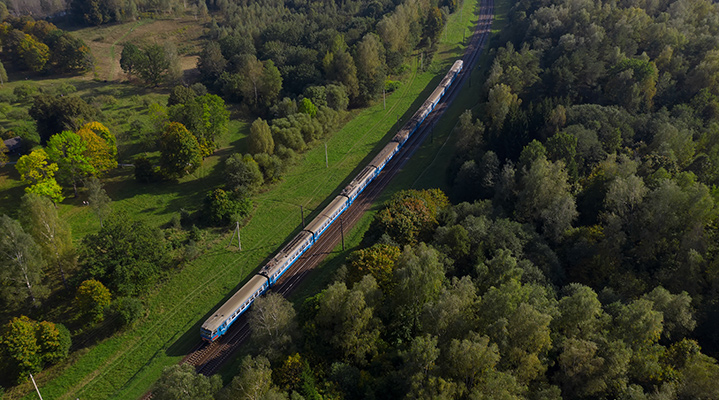
Fans of railroad travels will enjoy a trip to Belarus. The country’s longest railway route that connects Brest with Vitebsk and Polotsk offers an opportunity to see sights from a train and listen to the smooth sound of the wheels. The route is nearly 900km long (893km to be exact), crosses four oblasts (Brest Oblast, Gomel Oblast, Mogilev Oblast, Vitebsk Oblast), and takes about 19 hours. The train goes through Zhabinka, Kobrin, Pinsk, Luninets, Kalinkovichi, Zhlobin, Rogachev, Mogilev, Shklov, Orsha, Vitebsk, Shumilino. The train shuttles every day.
Taste genuine draniki
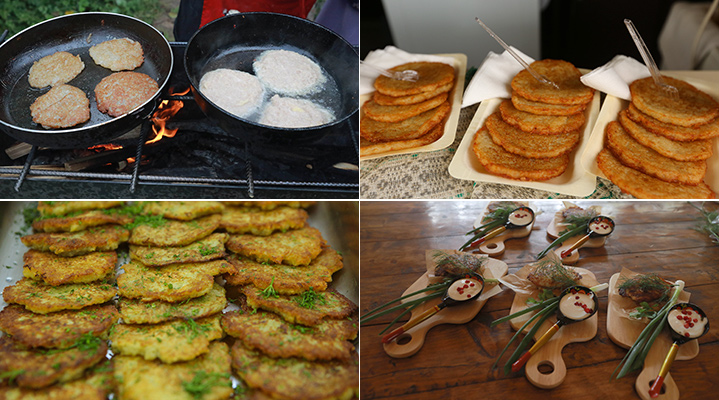
What is the first thing one recalls when Belarusian cuisine comes to mind? Potatoes and multiple dishes made of them! Although many nations cook various kinds of potato pancakes, draniki pancakes is a purely Belarusian dish. Despite the fact that Belarusians started growing potatoes only in the 18th century.
The first documentary recollections of draniki date back to 1830 and mention the cook Jan Szyttler. The “canonical” draniki recipe includes only four ingredients: potatoes, onions, salt, and oil for frying. Draniki can be eaten with sour cream, various sauces, and as a side dish of machanka.


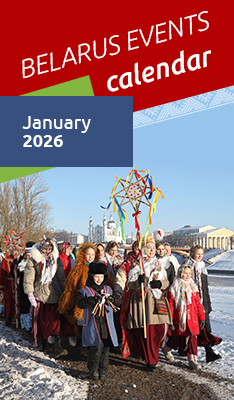




 print version
print version make home page
make home page add to bookmarks
add to bookmarks
